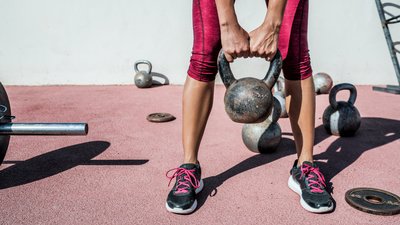Kettlebells are definitely having a moment right now. With news of a nationwide shortage and online classified listings for them reaching $4.50 per pound in my town (seriously!), the bell appears to be the unofficial training crush of the COVID-19 crisis.
Why? It's not because they promise unique results in any one particular area—say, muscle gain, fat loss, or cardiovascular conditioning. It's more because kettlebells have the reputation of spreading the gains across all of those areas—creating an overall athlete with strong shoulders, straight back, hard core, sturdy backside, and an engine that won't quit.
When I started training with kettlebells about 5 years ago, the initial appeal was that they felt more natural and comfortable than dumbbells for pressing movements. But I stuck with them because of how a steady diet of swings and squats carried over to, well, everything. I could power up hills in a hike; I'd hit a golf ball further; I'd be able to run my children into the ground playing in the park. It's a 'Ready for Anything" kind of feeling, and man, does it feel good.
Are kettlebells the only tools that can provide these results? Absolutely not. And no, they're not foolproof, nor some kind of overnight solution. But if you stick with them, they are definitely effective.
After attending numerous seminars, earning certifications, talking with some of the best coaches using kettlebells, and trying out countless protocols myself, here's what I've found to be the best training techniques to help the kettlebell-curious find that "Ready for Anything." You can put these techniques to work yourself in these three new BodyFit programs:
- Ready for Anything, Volume 1: Beginner Kettlebell Workouts
- Ready for Anything, Volume 2: Full-Body Kettlebell Workouts
- Ready for Anything, Volume 3: Double-Kettlebell Workouts

Technique 1: Timed Cluster Sets
Kettlebells can work well in traditional strength-and-size focused rep schemes like 5x5 or 3x8-12, but for most people, that approach isn't ideal. Why? Because few, if any, of us have a full rack of kettlebells to match the precise dumbbell and barbell loading schemes that usually go along with those reps.
When you only have a few weights to choose from, the key is to look for ways to do more work with what you have. That's where kettlebells really stand out, and where cluster sets can be your best friend.
Cluster training comes in different forms, but the common thread is multiple sets of low reps with short rests between them. You'll perform a set of, say, 2-4 reps, stopping before you reach failure, or right when a rep slows down the slightest bit. Then, you'll rest for usually just 15-30 seconds—or, in the case of single-arm presses, long enough to do your reps with the other arm—and repeat. In action, it's almost like a continuous rest-pause that can last minutes.
What's the point? Quite simply, it's racking up lots of high-quality reps with your chosen weight, rather than simply a couple of sets worth. If you perform, say, 5 clusters of 3-4 reps with a weight you can normally press for 6 reps, that's 15-20 reps total.
If you add the element of time into the workout, it gives you even more ways to progress. For example, a typical workout in Ready for Anything will tell you to perform clusters of the kettlebell Z-press for 5 minutes, alternating arms with each set. Over time, rather than simply trying to use a heavier weight, you could try to do more work in that 5 minutes. For instance, you could increase:
- How many total reps you performed.
- How much total weight you lifted.
Both of these metrics measure workout "density," an underappreciated type of progressive overload that can help you not only add strength and muscle size, but also boost conditioning and fat loss.
Pro tip: If you only have light weights, then just doing sets of 2-4 may be too easy. Boost your reps per cluster to where you stop each one the moment a rep slows down. It could take a workout or two to find the right weight, but yes, this approach can work just as well for light weights as for heavy ones.
Technique 2: High-Rep Goblet Squats
High-rep "breathing squats" routines have been around for nearly a century, but they usually involve a barbell on the back. The idea is to take a weight you can piston-pump for 10 solid reps, and do 20 reps with it, taking as many big, dramatic breaths between reps as necessary to get there.
Sound miserable? Yeah, it kinda is. But doing high reps with the weight held in front of you feels remarkably similar at a fraction of the weight. John Rusin, DPT, was the one who introduced me to the idea of the goblet squat "test" of 25 reps using half of one's body weight. You can read about it in the article "Don't Diss the Goblet Squat Until You've Survived This Workout."
Having tried it, I can say it's a unique experience unlike anything else in the weight room. The core, upper back and postural muscles, lungs, and willpower are all tested. And despite what people like to say about goblet squats not being heavy enough to work your legs, your lower body will be weeping. Submitting yourself to this once or twice a week will boost strength and posture, increase conditioning, and give your body a serious push toward being truly ready for anything.
Want a winning combination? Here you go: Swings twice a week. Moderate-rep goblet squats once a week. High-rep goblet squats once a week. It's a special kind of suck, but one worth gutting out. This isn't one you'll see in a lot of kettlebell workouts, so consider it our little secret.
Pro tip: You say you only have a couple of light kettlebells? Hold one in each hand in the racked position. Loop a band around your feet and through your hands. Then go to town.
Technique 3: Splitting Up Your Training Days
I'm not talking about creating a kettle-bro-split necessarily—although I have tried an upper/lower approach focused on kettlebells and body weight and loved it. Instead, I'm talking about splitting up your training like this:
- Workout 1: Slow lifts like squats, presses, and rows
- Workout 2: Fast lifts like swings, as well as loaded carry variations
Sure, there are plenty of workouts out there that will have you do both strength work and conditioning work in the same routine. But by separating them, you can devote more energy to each style of training, do more total work, and never feel completely crushed.
Technique 4: Reasonable Interval Swing Workouts
There is an endless heap of kettlebell swing workouts already in the world. What separates the good from the bad? In my experience, it's once again how you feel at the end. On one extreme, you can feel like you've just survived a murder attempt. On the other, you can feel like you wasted 15 minutes of your life on what a friend of mine calls a "no-twitch muscle fiber workout."
Somewhere in the middle, you can feel worked, but good. Maybe not like you want to fight a bear, but like you could still run away from one if you really had to.
Here are two popular approaches that I've had great success with. And by success, I mean simply that I and many other people have been able to predictably make progress with them, not get injured, and experience that "wow, I'm in great shape right now" feeling when hiking in the hills (which, for me, is the ultimate test of fitness).
- On-the-minute swings: Do a set of 8-10 reps at the top of the minute for 10-15 minutes. Alternately, combine ladders with OTM swings and do 5 reps one minute, 10 the next, and then 15. Then start again at 5.
- On-the-half-minute swings: Do a crisp set of 5, then rest until 30 seconds is up. Then do another set of 5. Keep going for 5-10 minutes, or even more. Pro tip: If you are gasping before a set starts, skip it and give yourself another 30 seconds until the next round.
Not sure about how to do kettlebell swings at all? Check out Geoff Neupert's article "Kettlebell Explosion: Harness the Power of the Kettlebell Swing."
Ready to stop reading and start swinging? Check out Ready for Anything in BodyFit Elite and the BodyFit App.


